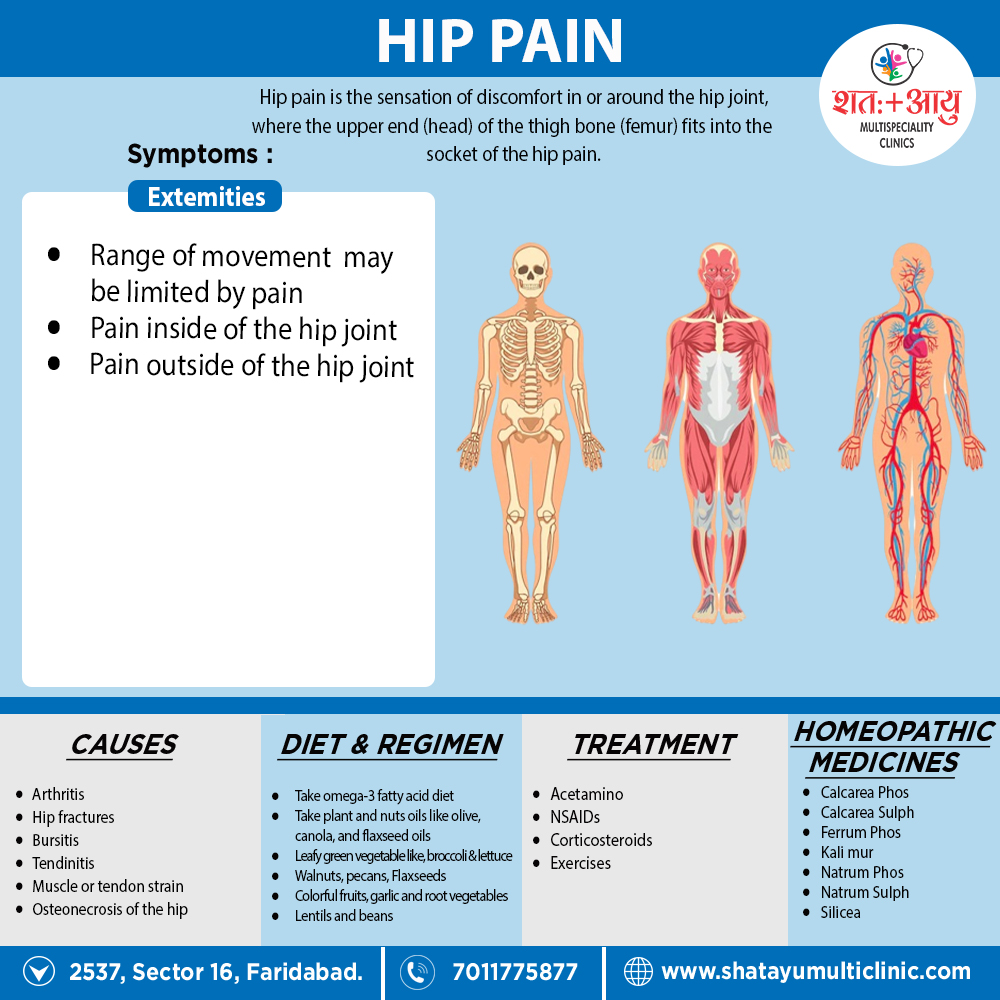Definition of Hip pain:
Hip pain is the sensation of discomfort in or around the hip joint, where the upper end (head) of the thigh bone (femur) fits into the socket of the hip bone. [1]

Hip pain is the sensation of discomfort in or around the hip joint, where the upper end (head) of the thigh bone (femur) fits into the socket of the hip bone. [1]
These are some of the conditions that commonly cause hip pain:
6. Osteonecrosis of the hip
Depending on the condition that’s causing your hip pain, you might feel the discomfort in your i.e.:
Sometimes pain from other areas of the body, such as the back or groin (from a hernia), can radiate to the hip.
You might notice that your pain gets worse with activity, especially if it’s caused by arthritis. Along with the pain, you might have reduced range of motion. Some people develop a limp from persistent hip pain. [2]
Additional evaluation is indicated with:
(1) Monoarticular conditions
(2) Traumatic or inflammatory conditions
(3) The presence of neurologic findings
(4) Systemic manifestations
(5) Chronic symptoms (>6 weeks) and a lack of response to symptomatic measures.
Homeopathy treats the person as a whole. It means that homeopathic treatment focuses on the patient as a person, as well as his pathological condition. The homeopathic medicines selected after a full individualizing examination and case-analysis.
which includes
A miasmatic tendency (predisposition/susceptibility) also often taken into account for the treatment of chronic conditions.
A homeopathy doctor tries to treat more than just the presenting symptoms. The focus is usually on what caused the disease condition? Why ‘this patient’ is sick ‘this way’?.
The disease diagnosis is important but in homeopathy, the cause of disease not just probed to the level of bacteria and viruses. Other factors like mental, emotional and physical stress that could predispose a person to illness also looked for. No a days, even modern medicine also considers a large number of diseases as psychosomatic. The correct homeopathy remedy tries to correct this disease predisposition.
The focus is not on curing the disease but to cure the person who is sick, to restore the health. If a disease pathology not very advanced, homeopathy remedies do give a hope for cure but even in incurable cases, the quality of life can greatly improved with homeopathic medicines.
The homeopathic remedies (medicines) given below indicate the therapeutic affinity but this is not a complete and definite guide to the homeopathy treatment of this condition. The symptoms listed against each homeopathic remedy may not be directly related to this disease because in homeopathy general symptoms and constitutional indications also taken into account for selecting a remedy.
Bryonia Alba –
Exercise, weight loss, and medication aren’t the only ways to alleviate hip pain. Additionally, omega-3 fatty acids are great for joint health, as they are known to reduce inflammation. Omega-3 fatty acids can be found in i.e.:
If you aren’t able to get enough omega-3 fatty acids through the foods in your diet, take fish oil supplements. [4]
Hip pain is the sensation of discomfort in or around the hip joint, where the upper end (head) of the thigh bone (femur) fits into the socket of the hip bone.
References